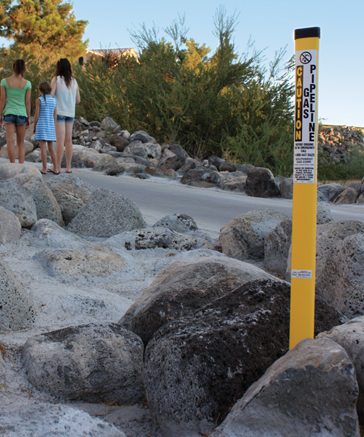Underground pipelines can be located anywhere
They can be found under public roads, railroads, street intersections, open fields, and on private property. For your protection, line markers are used to indicate the pipeline’s approximate location.
Calling 811 is still required for marking the pipelines before digging.
PIPELINE MARKERS
- Are yellow
- Are typically seen where a pipeline intersects a street, highway or railway
- Are not required for all pipeline facilities
- Do not indicate the pipeline’s depth or exact location
- List emergency telephone numbers in case of a natural gas emergency
Make sure markers are left undisturbed to serve as a reminder that natural gas lines are in the area. Additionally, below-ground markers, such as yellow tape or mesh, may be present to warn excavators to the presence of buried pipe. If this below-ground marking tape is encountered, stop work immediately and call Southwest Gas.

A right-of-way is a strip of land where some of the property owner’s legal rights have been granted to a utility company. By definition, pipeline rights-of-way allow the pipeline operator to inspect, repair, maintain, or replace pipeline on property owned by others. Pipeline markers are often placed along the rights-of-way to indicate the pipeline’s location.
Why are rights-of-way important to you?
Encroachments into the rights-of-way can cause unsafe conditions. When a pipeline is accidently damaged by excavation and other construction activities, outages, impaired access, excessive/dangerous loads on the pipeline, and evacuations can occur.
Safety of the rights-of-way can be promoted by:
- Calling 811 to get utility-owned underground lines marked before excavation.
- Using safe excavation practices.
- Monitoring and reporting suspicious activity on the rights-of-way.
- Keeping rights-of-way free from obstructions.
- Following recommended practices on land use near the rights-of-way.
The Southwest Gas service territory map provides general locations of our transmission pipelines. Lower pressure distribution mains and service lines connected to the gas meter at homes and businesses are not shown.
To locate natural gas transmission lines operated by Southwest Gas and other companies, visit the U.S. Department of Transportation’s Pipeline Mapping System (NPMS) website.
Pipeline Integrity Management Programs
Southwest Gas is committed to operating safe natural gas pipelines that meet or exceed all local, state and federal regulations. Our Integrity Management Programs were developed to ensure the integrity of natural gas transmission and distribution pipelines and to comply with the requirements of the U.S. Department of Transportation §49 CFR Part 192, Subpart O – Gas Transmission Pipeline Integrity Management (TRIMP) and Subpart P – Distribution Integrity Management Program (DIMP).
Our TRIMP includes proactive prevention of transmission pipeline failures, with a focus on High Consequence Areas (locations along the pipeline with high population density and places where people congregate, such as schools, hospitals, parks, and churches). This is achieved through:
ANALYSIS & ASSESSMENT
- Risk modeling
- In-line inspections
- Pressure testing
- Direct assessment
PREVENTION MEASURES
- Extra patrols along the pipeline
- Additional leak surveys
- Remote control valve installation
- Emergency response drills
DAMAGE PREVENTION
- Safe excavation practices
- High-pressure standby
- One-call programs
- Excavator training
Our DIMP addresses the integrity of distribution facilities including service lines to homes and businesses by identifying risks and threats. This is achieved through:
OPERATIONS & MAINTENANCE
- Leak survey and repair
- Threat identification
- Replacement projects
MATERIAL INVESTIGATIONS
- Examining failed components
- Determining leak causes
- Identifying threats
DAMAGE PREVENTION
- Protecting company facilities from excavation and vehicular damage and natural forces
- One-call programs
- Excavator training
CROSS BORE ELIMINATION
- Removal of intersections of gas and sewer piping
- Educating plumbers and public
Southwest Gas continually collaborates with local emergency response officials through regular meetings, participation in emergency response drills, and ongoing review of deployment practices. This allows each organization to refine safety procedures, and coordinate how to respond with others involved more effectively in the event of a natural gas incident or emergency. Additionally, Southwest Gas provides ongoing pipeline safety training to our employees and contractors. If you'd like to schedule a meeting or a joint emergency response drill, or would like more information about training, please call
800-654-2765
.
For California Customers
Pursuant to California General Order 112-F, the following link provides a summary of California public agencies, to which Southwest Gas provided notice of, and made available for participation at its annual liaison meetings for calendar years 2020 through 2025.
Neighbors like you can help us maintain a safe, secure, and reliable pipeline system. If you observe any unusual or suspicious activity near our pipeline facilities, please call Southwest Gas immediately at
877-860-6020
.
How to recognize a natural leak
Learn the signs of a natural gas leak and what to do if you suspect one.
Committed to Safety.

At Southwest Gas, safety is our top priority. We work year-round to protect our communities by regularly inspecting pipelines, following strict construction standards, upgrading infrastructure, and testing materials for long-term reliability.
PUBLIC SAFETY MESSAGE
Check out our informative video to learn the basics of natural gas safety.








 Excavators
Excavators











